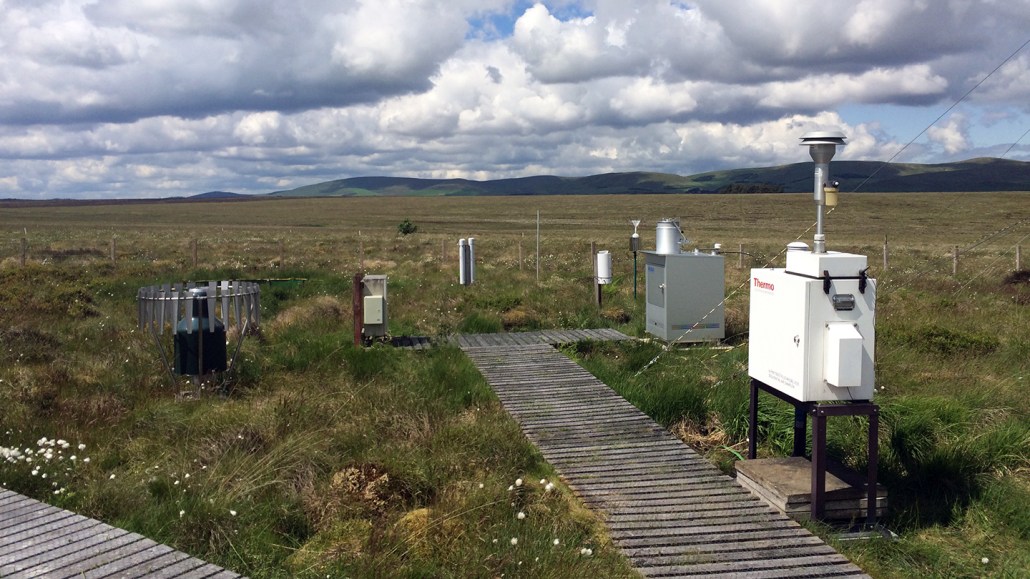
Paper filters from the Auchencorth Moss air quality monitoring station in Scotland (shown) were chock full of genetic material from local animals and plants. Similar facilities around the globe could help researchers track biodiversity.
Local Site Operator/ National Physical Laboratory
- More than 2 years ago
The ability to track animals and plants is up in the air — literally — thanks to help from an unexpected source.
Around the globe, many air quality control stations filter air through small paper disks on a daily or weekly basis, allowing scientists to ensure concentrations of hazardous pollutants such as heavy metals are below certain levels. But the filters also pick up plant and animal DNA that has been scattered into the wind, researchers report June 5 in Current Biology.
The eDNA, short for environmental DNA, on those filters could make air quality control stations a treasure trove of samples cataloging local animals and plants. Such records could help researchers track biodiversity at a larger scale than ever before and more easily catch species declines or track how ecosystems are changing overall.
“It’s this incredible system that already exists, and we’re effectively piggybacking on it for a totally new use,” says Elizabeth Clare, a molecular ecologist at York University in Toronto. The facilities are widespread across North and Central America, Europe and Asia but are less dense in the global South.
“It never occurred to us that these filters capturing particulate matter could even be analyzed for environmental DNA,” says James Allerton, an air quality scientist at the National Physical Laboratory in Teddington, England. That changed when Allerton read a news story about two studies where scientists vacuumed animal DNA out of thin air at two zoos, one in England — led by Clare — and another in Denmark (SN: 1/18/22).
Learning about the potential for capturing eDNA sparked a “light bulb moment,” Allerton says, and he reached out to Clare to collaborate. The Teddington facility holds onto its pollution-monitoring filters for a year in case scientists need to do a repeat measurement for heavy metals, meaning there could be a year’s worth of eDNA to claim, he realized.
Clare, Allerton and colleagues analyzed filters from the Teddington facility that were exposed to ambient air for one hour, one day or one week. The team also examined eight-month-old filters from an air quality control station in Scotland that had each been exposed to air for a week.
Genetic material in the filters revealed the presence of more than 180 different types of local fauna including pine trees, badgers, owls, fungi and newts. That volume is surprising given that the filters and storage conditions weren’t set up with eDNA in mind, says David Duffy, a biologist at the University of Florida’s Whitney Laboratory for Marine Bioscience in St. Augustine. That the researchers recovered so much eDNA from a system designed to monitor air quality shows how prevalent airborne DNA is and how much biodiversity data could be up for grabs.
The filters detected plenty of plant life, even on disks exposed to air for only an hour. Birds and mammals, on the other hand, were more likely to pop up in samples taken for longer periods of time. That’s probably because trees are stationary while animals are constantly moving around, so it takes more time to detect them, Clare says.
She notes that even older samples might exist. There are numerous filter-using stations around the globe, some of which have never thrown the disks away since their opening. “We do know of some places where there are potentially 50 or 60 years of these stored,” Clare says. It’s unclear if those samples are viable, but the idea being able to track biodiversity that far back is “unbelievable.”
Not every air quality control station uses filters to monitor pollution, says Fabian Roger, an ecologist at ETH Zürich. Many stations rely on sensors that can detect airborne particles in real time. Those sensors can’t capture eDNA, so the number of suitable facilities to extract such genetic material will vary from place to place.
But air quality control stations that do rely on filters certainly have great potential, says Roger, who is also studying how the facilities could help biodiversity efforts. He says that researchers now need to figure out how useful the genetic information is. It’s unclear how closely the DNA from filters matches local fauna, he says. How far away any sources of DNA might be, whether it’s a few blocks, a few kilometers or even farther, is also unknown.
Answering those questions is a priority, Clare says. Still, “the idea that there’s something that’s been collected daily or weekly, that’s just unheard of in our discipline,” she says. “And if [an air quality control station] has the potential of producing data that’s this rich over and over and over and over again, that is an unbelievable treasure of biodiversity information that we have never noticed.”






